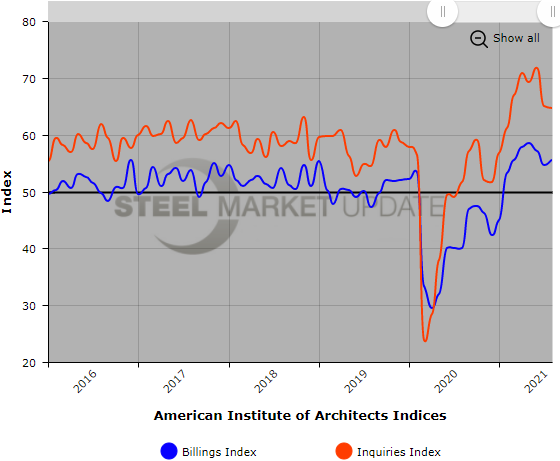Economy

August Architectural Billings Index: Seventh Month of Improvement
Written by Brett Linton
September 23, 2021
Demand for design services from architecture firms in the U.S. improved for the seventh consecutive month, said the American Institute of Architects. AIA’s Architecture Billings Index rose from 54.6 in July to 55.6 in August. The ABI has expanded each month since January.
The index for new project inquiries fell by 0.3 points to 64.7, while the new design contracts index slipped 1.4 points to 56.6, said AIA.
“The surge in design activity continued in August, signifying an expected upturn in construction activity in the fourth quarter and continuing into 2022,” said AIA Chief Economist Kermit Baker. “This expected expansion will magnify the already serious problems of price inflation and availability of many construction products and materials, as well as the emerging labor shortages in the industry.”
The Architecture Billings Index is an economic indicator for nonresidential construction activity, with a lead time of approximately 9-12 months. A score above 50 indicates an increase in activity, and a score below 50 a decrease.
Key ABI highlights for August include:
- Regional averages: West (57.2); Midwest (55.2); South (52.5); Northeast (51.7)
- Sector index breakdown: mixed practice (56.0); commercial/industrial (54.7); institutional (54.4); multi-family residential (54.3)
Regional and sector scores are calculated as three-month averages.
Below is a graph showing the history of the AIA Architecture Billings Index. You will need to view the graph on our website to use its interactive features; you can do so by clicking here. If you need assistance logging into or navigating the website, please contact us at info@SteelMarketUpdate.com.


Brett Linton
Read more from Brett LintonLatest in Economy

Chicago Business Barometer falls back in April, remains in contraction
The Chicago Business Barometer declined in April, reversing March’s gains, according to Market News International (MNI) and the Institute for Supply Management (ISM).

Fewer manufacturers optimistic about the economy
PMA’s April report shows that only 16% of surveyed manufacturers anticipate an increase in economic activity in the next three months (down from 23% in March)

Architecture billings continue to slide in March
Architecture firms said billings continued to decline in March, according to the latest Architecture Billings Index (ABI) released by the American Institute of Architects (AIA) and Deltek.

Beige Book shows concerns about trade policy
Manufacturing was mixed, but two-thirds of districts said activity was little changed or had declined.

New York state manufacturing index drops again in April
Firms were pessimistic, with the future general business conditions index falling to its second lowest reading in the more than 20-year history of the survey
